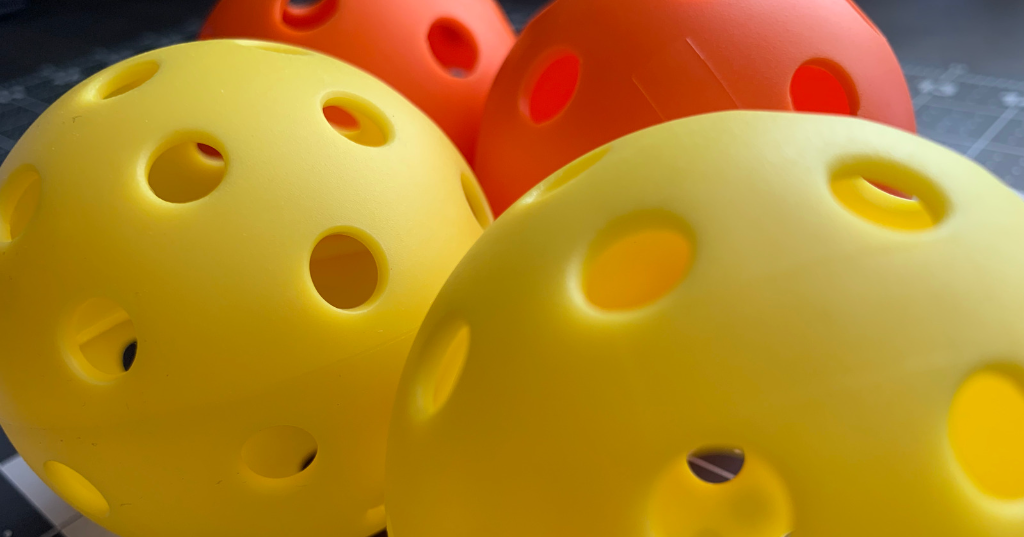To an outsider, pickleballs might seem like Wiffle balls and to a beginner, a pickleball might seem like a commodity where every ball is the same. But, a pickleball is quite different from any other ball, and there's a wide range of options of pickleballs to boot, such as indoor and outdoor. So how do you tell the difference between indoor and outdoor pickleballs?
The biggest difference between indoor and outdoor pickleballs is the quantity and size of holes. Indoor balls typically have 26 larger holes while outdoor usually have 40 smaller holes. Climate and court surface affect ball choice, which in turn affects weight, hardness, texture, and durability.
In short, everything is different between indoor and outdoor pickleball. They may be two sides of the same coin, but depending on which you choose, you’ll find playing harder or easier because of their stark differences and unique purposes. Let's explore 5 major differences between indoor and outdoor pickleball.
How Do You Tell the Difference between Indoor and Outdoor Pickleballs?
To the untrained eye, indoor and outdoor pickleballs might look similar enough. Once you've held an indoor and outdoor pickleball or had them side by side, the differences become glaringly apparent.
Of course, there are exceptions to these 5 differences, but in general, the majority of indoor and outdoor balls are unique in the following ways:
- Number of Holes: Indoor balls have 26 holes while outdoor balls have 40.
- Hole Diameter: Indoor balls have holes with wider diameters than outdoor balls.
- Weight: Outdoor balls tend to be heavier than indoor balls.
- Hardness: Outdoor balls tend to be harder plastic than indoor balls, aiding with more bounce.
- Durability: Because outdoor pickleballs are harder they tend to crack quicker than softer indoor pickleballs.
While each brand and type of pickleball has several specifications to make it unique, USA Pickleball has created metrics for getting a pickleball approved by its governing body.
Let's look more closely at 5 of the difference between indoor and outdoor pickleballs.

1. Number of Holes
While pickleballs may appear to be just plain plastic, don't let that fool you! Each ball is thoughtfully designed with holes for a very important job: maintaining the consistency and flight trajectory of your shots.
Outdoor balls have 40 closely-packed holes while indoor varieties usually feature 26 wider holes. But why?
It's all about staying true to each shot and neutralizing as many external factors as possible, such as wind or the surface of the court. The numerous smaller holes on outdoor pickleballs offer more robustness for playing in windy conditions.
Believe it or not, those little holes are meddling in aerodynamics for a truer bounce and shot.
Each hole is beveled into the plastic of the pickleball and features uniform size and placement across the ball, although there are some exceptions to this, as some outdoor pickleballs have two sizes of holes on the same ball.
USA Pickleball - Number of Holes on a Pickleball (2.D.8.)
The ball shall have a minimum of 26 to a maximum of 40 circular holes...
The official manufacturer's guidelines don't callout the number of holes per indoor or outdoor playing situation. So technically, you could have a 26-hole outdoor ball.
This is part of the reason you may come across a 32-hole ball for outdoor.

2. Hole Diameter
The diameter of holes on a pickleball changes drastically by brand and model, and certainly between indoor and outdoor balls. As you know, indoor pickleballs have wider holes than outdoor pickleballs, but do you know how much wider?
How Wide Are the Holes of Indoor and Outdoor Pickleballs?
On average, the holes of indoor pickleballs measure .43-inches in diameter, while outdoor pickleball hole diameters measure roughly .282-inches. This is a significant difference between the two, making an indoor pickleball hole diameters 40% larger than outdoor pickleball holes.
This data was pulled by measuring 10 of the more common indoor and outdoor pickleballs on the market today. While there are certainly outliers beyond this small informal research, it's at least helpful from a directional standpoint for understanding just how much larger the holes are in indoor pickleballs.
USA Pickleball - Hole Diameter on a Pickleball (No Rule)
There are no specific regulations on the hole diameters of indoor vs. outdoor pickleballs.

3. Weight
Outdoor pickleballs typically weigh more than indoor pickleballs. This is one of those points that a lot of players know, but may not necessarily know how different the weights are.
It would make sense that outdoor pickleballs would be heavier than indoor pickleballs, for a couple of simple reasons.
First, the holes contribute to weight. Even though indoor pickleballs have fewer holes (26 total) than outdoor pickleballs (40), because of their significantly larger diameter (40% greater on average), the 26 holes of indoor pickleballs cover more surface area than the 40 holes of outdoor pickleballs.
This means there is more negative space in indoor pickleballs, contributing to a lighter weight.
The second reason is more of a logical approach. Due to external conditions like wind interference, having a heavier ball for outdoor play would be more beneficial to keep a ball true to its intended course.
There are other components like materials at play, but we'll cover those in a minute.
What Is the Weight Difference between Indoor and Outdoor Pickleballs?
Outdoor balls technically weigh more than indoor balls, but the difference is nominal at less than 1%. Based on a small sample of indoor and outdoor pickleballs, the average indoor pickleball weight was .917 ounces, while the average outdoor pickleball weight was .925 ounces.
Within the sample of balls, there was the highest variance among outdoor pickleballs, where the lightest weighed in at .897 ounces.
USA Pickleball - Weight of Pickleballs (2.D.4.)
The ball shall weigh between 0.78 and 0.935 ounces (22.1 and 26.5 grams).
There are no restrictions to weight by classification, such as a min or max for indoor vs outdoor pickleballs. And based on the basic research for this article it seems like the sweet spot for ball weight is shared across indoor and outdoor pickleball.
Weight may not have as big of an impact on gameplay so much as aerodynamics due to the hole patterns and sizes.
4. Hardness
Everyone knows that pickleballs are made of plastic - you can tell that just by looking at them. But not all plastics are created equal, and there's certainly a variety of plastics that brands will use to make pickleballs.
Pickleball hardness is measured with something called the durometer hardness test, which uses Shore D values for plastics. It's all just a fancy scientific way of grading the hardness of hard rubbers and plastics on a scale of 0 to 100, where 100 is the hardest.
Of the common plastics and hard rubbers used in pickleball, they cover quite a range of typical hardness. The scale below for each will give you a general idea of where each material rates, although they could certainly be higher or lower based on the specific ball:
- LDPE - Low-Density Polyethylene: 40-50
- HDPE - High-Density Polyethylene: 60-70
- PP - Polypropylene: 70-83
- PET - Polyethylene Terephthalate: 85-95
In general, balls made of something like TPE (often referred to as thermoplastic rubber) is going to be far spongier than a ball made with HDPE. And this is an important part of determining materials used for indoor and outdoor pickleballs.
Arguably, the hardness of a pickleball has the most influence on its performance. And three metrics that directly or indirectly gauge the hardness of a pickleball: hardness itself, compression, and bounce.
Which is Harder - Indoor or Outdoor Pickleballs?
Outdoor pickleballs are typically harder than indoor pickleballs. This is primarily the result of materials and construction thickness used in creating specific balls, as well as the weight. A harder ball plays faster, whereas a softer ball is ideal for indoor pickleball court surfaces, resulting in a slower pace.
Both indoor and outdoor pickleballs are made of plastic, but it’s the type of plastic that sets them apart. Indoor pickleballs are made of a softer plastic for a lightweight profile. That type of plastic is more prone to drag.
Outdoor pickleballs are built using thicker, harder, and heavier plastic to increase the ball’s outdoor durability.
USA Pickleball - Hardness of Pickleballs (2.D.7. No Longer Required)
Hardness used to be a required measurement for approval of pickleballs by USA Pickleball, however, this was overturned. For a general idea of hardness though, the rule used to require pickleballs to have a Shore D of 40-50, which would be on the low-medium end of plastic hardness.
Of importance though, there is no general rule on hardness, bounce, or compression assigned to indoor or outdoor balls specifically, but there are standards for compression and bounce for all pickleballs.
Both of those measures are indirect ways of showing the hardness of a ball (rules 2.D.6. and 2.D.5.)

5. Durability
Contrary to the belief of many beginners, pickleballs lose their shape and won't last a lifetime, and that goes across indoor and outdoor pickleballs. Look no further than a hard outdoor ball. Over time, temperature, and use, you'll start to notice a ball cracking with play.
Durability is heavily influenced by the materials and construction of each pickleball, but in general, the harder the material, the more likely a shorter lifespan.
Materials like TPE have such high elastic properties that they are far more difficult to crack or change shape. Whereas harder plastics seem to crack when you look at them wrong.
Which Type of Pickleball is More Durable?
Indoor pickleballs tend to be more durable as they typically use softer plastics than the hard plastics of outdoor pickleballs. The harder plastic of outdoor pickleballs makes them prone to cracking, splitting, and losing shape. Indoor balls typically get soft spots at the end of their lifespan.
Neither ball will last forever, but on average, an indoor ball will last far longer than an outdoor pickleball.
USA Pickleball - Durability of Pickleballs (2.D.1.)
The ball shall be made of a durable material...
Not the most specific regulation, right? In terms of enforcement, this could be a tough one, but if there's one thing players hate more than anything, pickleballs that don't last long would be top of the list.

Can You Use Indoor Pickleballs Outdoors and Vice Versa?
Can you flip the script and use an outdoor pickleball when playing indoors, or an indoor ball when playing outdoors?
You can technically use an indoor pickleball outdoors and vice versa, but it's not advised. Using an indoor ball outdoors is a worse idea than using an outdoor ball indoors, as an indoor ball is too lightweight, not crafted for wind interference, plays too slowly, and isn't the right build for outdoor courts.
It's far more common to see an outdoor ball played indoors than to see the opposite, but ideally, you'd use an indoor ball indoors and an outdoor ball outdoors. If you bring an indoor ball to play outdoors, prepare to get some interesting looks from others.
Let’s talk about this a little bit more.
Indoors, the conditions on the pickleball court are incredibly predictable. While wind conditions get a lot of discussion on this topic, and rightfully so, there is still one big factor that's overlooked, and that's the sun.
If you're playing pickleball midday in a Florida summer, you have to believe this is going to impact a pickleball made of a lighter plastic, which would be indoor balls more often than outdoor pickleballs.
The Right Pickleball Matters
The truth is, it’s important to always use the right pickleball for the right conditions. Indoors and outdoors are vastly different environments and as such require different balls to provide the best playing experience.
You can get away with using outdoor pickleballs indoors, but for optimal play comfort, you need to use the right type of pickleball. And by no means should you try to use an indoor ball outside. It will just leave you frustrated beyond belief.
So while you can tell the difference between pickleballs just by the number of holes and hole size, other factors like weight, hardness, and durability combine as five factors that make indoor pickleballs completely different from outdoor pickleballs.



Leave a comment
This site is protected by hCaptcha and the hCaptcha Privacy Policy and Terms of Service apply.